How to Connect a Mac to a TV with HDMI for Full Audio & Video Support
Ever wanted to connect a Mac to a TV screen? Maybe you want to use the TV as a giant external monitor, to play games on a big screen, or just for video playback and movie streaming? It’s actually quite easy to do, and we’ll cover the entire process from start to finish. We’re going to focus on connecting any newer Mac to any fairly modern TV by way of a physical HDMI connection, thus, a few third party accessories will be necessary for the task. The result will be the Mac exporting both video and audio signals to the TV.
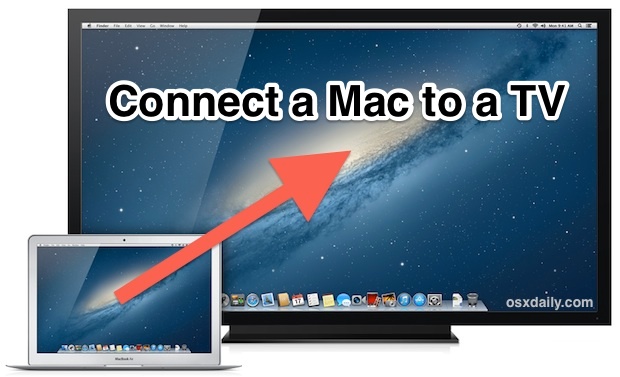
HDMI is really the best way to connect a MacBook Air, MacBook Pro, MacBook, iMac, or Mini to an HDTV screen, whatever your intended usage purpose is. Yes, the AirPlay feature can also export a screen to show up on a TV through an Apple TV box, but the HDMI method has several distinct advantages; it’s cheaper, resource usage is considerably less, there are no slowdowns, the video quality does not depend on network latency, and it’s just generally much more versatile, making the only real downside to the HDMI approach being the physical cable connectivity. Lets get started and cover the basic requirements first.
Requirements:
Virtually every semi-modern Mac will fit the bill, but you will need the following:
- Mac with Mini-DisplayPort, Mini-DVI*, HDMI, or Thunderbolt port
- Mini DisplayPort/Thunderbolt to HDMI Adapter with Audio Support
 ($10-$15)
($10-$15) - HDMI cable
 ($5-$20 depending on length)
($5-$20 depending on length) - HDTV with HDMI input, just about any modern HDTV

Note about HDMI adapters and audio support: there are many options available on Amazon and some are very cheap, many of which will not actually carry audio despite advertising that they do. Generally, the adapters that cost a little bit more tend to be more reliable, so be sure to read the reviews and make sure that audio does indeed work for the adapter you are ordering. I’ve had the best experience with the Monoprice brand, but your mileage may vary. Also note that for 2010 and older Macs, the Mini-DVI to HDMI adapters do not carry audio at all, thus you will need a separate audio output option that we won’t cover here (external speakers, separate audio cable, etc).
If you plan to control the TV using your Mac from a distance, spend a couple extra bucks on a longer HDMI cable. 15 feet is usually adequate for most cases, but if you have a gigantic room you may want a longer cable.
For the purpose of this walkthrough we’ll focus on the newer Mac models with a built-in HDMI, Mini-DisplayPort, and/or Thunderbolt ports, this guide was crafted using a MacBook Air and MacBook Pro, but the same applies to newer Mac Mini and iMac models too. Again, note that the latest MacBook Pro models have an HDMI port, so you wouldn’t need an adapter on one of those MacBook Pro models, you can just directly connect an HDMI cable between the Mac and the TV.
Connect the Mac to the TV with HDMI & Adapter
Establishing the initial connection is remarkably straightforward and is just a matter of physically connecting the cables to one another from the Mac to the TV.
If the MacBook Pro has an HDMI port, you can just connect the HDMI cable to the port, this is what it looks like:
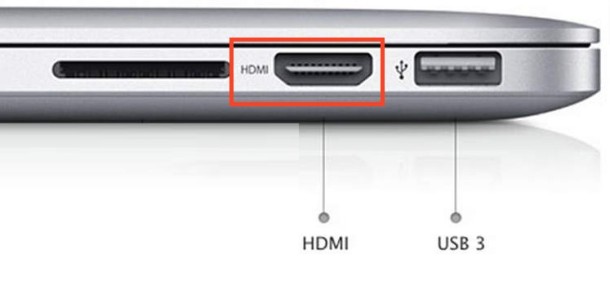
If the MacBook, MacBook Air, MacBook Pro doesn’t have an HDMI port, and you have never connected anything to a Mini-Display Port or Thunderbolt Port, you’re looking for this port which requires the adapter:

The location of the video output port varies per Mac model, but it’s usually on the right-side of the MacBook Air, the left side on the MacBook Pro, and it’s always on the back of the iMac and Mac Mini. The Mini-DisplayPort to HDMI adapter that connects to the Mac will look something like this:
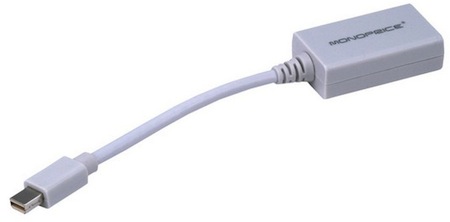
With everything ready, it’s time to hook everything up and get the connection going, here’s how to connect the Mac to a TV with HDMI:
- Connect that HDMI adapter to the video output port on the Mac
- Connect the HDMI cable to the adapter (or directly to the Mac if it has an HDMI port) and the other end of the HDMI cable needs to go into an available HDMI source port on the back or side of a TV
- Turn the Mac on if it isn’t already
- Flip the TV’s video input source over to HDMI (often through a “Video Source” button on the TV’s remote control)
The Mac should instantly recognize the TV and extend the desktop over to the HDTV’s screen. If that doesn’t happen, you are probably on the wrong video source of the TV, so try another HDMI source. Some modern HDTV’s have up to 6 HDMI ports, meaning you’ll have to flip through each of them to find the proper one carrying the Macs video and audio output signal. You’ll know it works because the desktop shows up on the TV instantly like this:
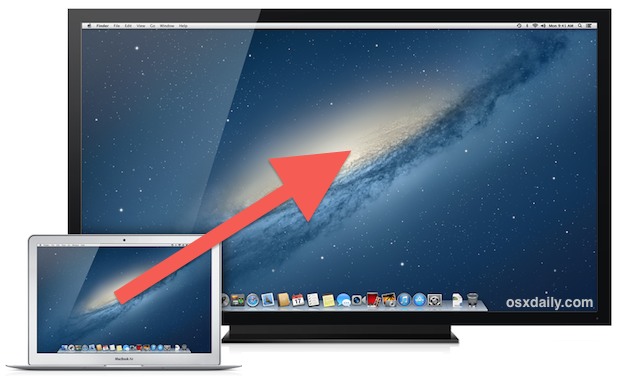
If you’re satisfied with this alone, which basically makes the TV an external display, then you can call it quits here. On the other hand, if you’re looking to watch movies through apps, watch web video, or use another playback source from the Mac on the larger TV screen, then you’ll want to take a few additional steps to greatly improve the experience. Plus you’ll probably want to get sound working properly, as you’ll notice by default audio won’t play through the TV screen and stays playing through the Macs speakers instead. Read on to optimize the TV for video playback, get sound working, and for some more tips for having the best experience.
Configure the Mac Video Output for Optimal Display on the TV Screen
By default the Mac will attempt to use the TV as an external display, extending the desktop to the TV screen. That’s great if you intend on using the TV as a large external monitor, but if you’re aiming to watch video or a movie, or play games, you’re better off using Display Mirroring in many case. Option A describes how to do this easily:
A: Set Up Mirroring
- With the Mac connected to the TV, open System Preferences
- Choose “Displays” and then click the “Arrangements” tab
- Check the box for “Mirror displays”

While this almost always looks better on a 720p TV screen, that’s not always the case for 1080p HDTV’s. Since the 1080p resolution is greater than that seen on many Mac displays, you’ll either need to scale down the resolution, deal with a pixelated image, or just set the external display as the primary display and go into full-screen mode on the TV screen when playing video as described in Option B:
B: Set the TV Display as the Primary Display
- Open System Preferences from the Apple menu after the Mac & TV are connected to one another
- Choose “Displays” and then go to the “Arrangements” tab
- Drag the white menubar from the smaller built-in display to the external TV display, thereby turning the TV into the primary screen
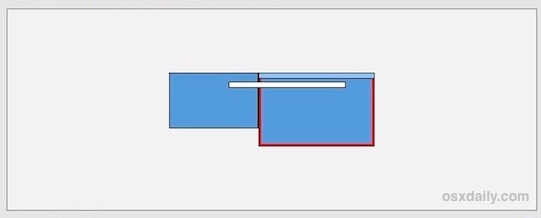
This will reverse the default configuration of a dual-display setup, thereby turning the Macs screen into the extended desktop, and the HDTV as the main desktop where the menu bar shows and apps appear by default.
Change Sound Output from the Mac to TV via HDMI
Unless the Mac is hooked up to some great external speakers, you’ll almost certainly want to set audio output to go through the TV’s speakers rather than the tiny ones built into the computer. For just about every HDMI based Mac-to-TV connection, these audio settings must be adjusted manually after the two have been attached to one another and video is already displaying on the TV screen:
- Open System Preferences from the Apple menu and choose “Sound”
- Click the “Output” tab and look under the “Type” list to find the “HDMI” option and select it

The Output tab will usually show the TV’s model name, but since most people don’t know the model number of their TV that’s fairly meaningless and it’s much easier to just look for “HDMI” in the list. In the screenshot example, the LCD HDTV’s model is “VO320E” for a Visio 32″ but the names are often much more convoluted than that.
Note that once you set the audio output to go through the TV you will lose the ability to adjust the sound volume levels through the Mac’s audio output controls, meaning you’ll need to use the TV’s built-in volume adjustment buttons or a remote control.
Get a Good Video Playback App
If the entire reason you’re doing this is to watch videos on a bigger screen, be sure you get a good video playback app. Here are four great free apps:
- XBMC – media center and much more, plays almost any video you can throw at it
- Plex – media center app that also plays virtually every video format
- VLC – barebones but powerful video playback app that works with nearly all video formats
- MplayerX – more full-featured video player that is compatible with the majority of video formats
QuickTime Player is also a fine choice for playing .MOV, m4v, .mp4 files, but for other movie file formats like .WMV, Flash .flv, .mpeg, .avi, and others, you’ll want to get a third party app instead. For other formats, VLC is a classic app and should be included in just about every Mac users app toolbox, and MplayerX is becoming increasingly popular for being just as versatile while having the added bonus of supporting BluRay and MKV playback.
Both XBMC and Plex are full featured media apps, which are capable of turning a Mac into a media center when they’re running. If you have a spare Mac, you can even turn it into a full-time media center, server, and torrents box, and the Mac Mini is particularly great for that purpose.
Video Playback Too Small? Black Bars Showing? Use Screen Zoom
Not all movies or videos will play at true full screen, and sometimes you’ll end up with a large black border around the sides of the video. This is frequently true with many web-based streaming movies, or when playing video that is lower resolution in general. Some playback apps like QuickTime and VLC have the ability to play video at 1.5x and 2x resolution to solve that problem, but for web players and other apps you can just use screen zoom instead.
First, let’s enable screen zoom if you haven’t done so yet:
- Open System Preferences from the Apple menu and choose “Accessibility”
- Choose “Zoom” and enable the zoom features, choose either the keyboard shortcut or zoom gesture option

Optionally, check the “Smooth Images” option to attempt to have less pixelation when zoomed in, though this tends to blur the picture for heavy zooming and can look strange. You’re better off trying this out yourself to see if it works for the video you want to watch.
Now to put this to you use, play back a video as usual either from a web player or movie file, center the mouse cursor in the middle of the video, and now use the zoom feature to eliminate the black borders. For those who enabled the gesture option, this is done by holding the “Control” key and then using a two-fingered upward gesture to zoom in (or two finger down to zoom out).
For example, this video of an older NOVA Origins video is fairly low resolution, and when maximized in the web-based player it still won’t play at full screen. This is a perfect situation to use screen zoom for, which turns this:
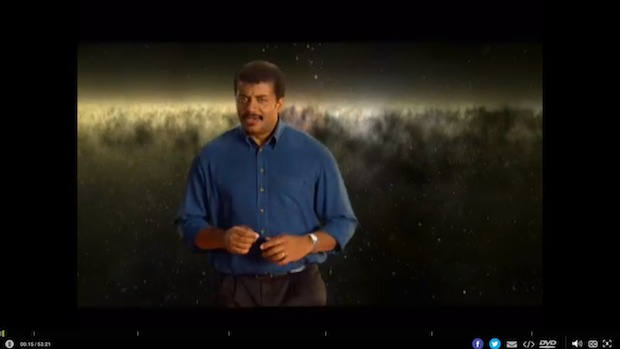
Into this full-screen maximized version, simply by zooming in on the playing video:
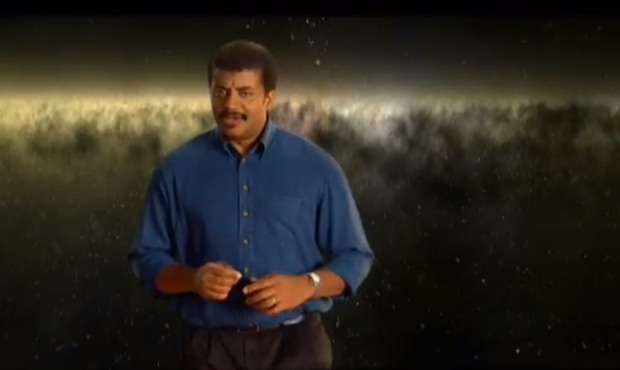
Much better huh? It won’t do a anything to resolve the lower resolution playback, but at least it doesn’t have the large black bordering bars showing alongside all of the video, making the playback itself smaller than it needs to be. Sometimes just increasing the web browser zoom works too for just web video, but that shouldn’t be considered universally reliable enough to recommend for all situations.
That should be about it, enjoy your Mac-TV hookup, go watch some movies, browser the web on an enormous screen, game on the big screen, and have fun!

Sidenote: If you happen to have an Apple TV and a Mac running 10.8 or later, you can just use AirPlay Mirroring and do this entire thing wirelessly without the need for any cables or HDMI adapters. Typically AirPlay offers excellent video playback, but on weak wi-fi signals the connection can suffer, which is never a problem with a physical HDMI cable. Plus, the combination of an HDMI adapter and cable is about 1/10th the price of an Apple TV box, making the method offered above a much more economical choice.


Use Apple’s USB-C Digital AV Multiport Adapter. It’s $69, but it works easily and perfectly.
My MacBook Pro just says “Could not load Sound preference pane,” so I cannot get the sound through the TV at all — just the video.
Thank you so much for this information. It is so helpful. Looking forward to getting my computer connected to my TV now.
Thanks for the very clear article…
but audio is still not working…
The windows laptop works on the TV in question using the same HDMI Cable (audio and video).
This 2019 MacBook Pro (Catalina 10.15.2) works on a different TV using the same USB-C to HDMI adapter. (so I know the adapter supports audio), but it will not work on the TV in question! The sound output in Preferences lists the Panasonic TV, the video works, but there’s no sound.
Can you help?
Ben
I recently purchased a generic USB-C to HDMI adapter. It worked perfectly with my Dell, but no audio with my MacBook Pro. I tried numerous suggestions I found online (short of rewriting computer instructions/code) with no success. I finally tried my Apple USB-C Digital AV Multiport Adapter that I have been using for a desktop station setup. It worked perfectly! Unfortunately, it’s $69.
I use a mac air. I couldn’t find an Arrangements tab in Displays.
I have 2010 imac desktop, and am trying to use viseo flatscreen as my display. Im using thunderbolt (or mini display) to hdmi cable – no adaptors, just single cable with hdmi on one end and thunderbolt on the other.
Imac is not recognizing any alterbative display whatsoever. Secondly, i tried using a thunderbolt to dvi cable, with a dvi to hmdi adaptor… still sane results – no recognition.
Wtf? Any help greatly appreciated
Hi Elsworth. Did it work for you or any solution? I am facing similar issue. Trying to connect thunderbolt 2 port on mac mini to HDMi on Vizio TV with amazon basics cable same as yours – no adaptors. TV is not recognizing any input.
I have monitors connected via USB C and HDMI (via Apple adaptor) to my MacBook Pro. However, the only option in the Sound Control Panel is “internal speakers.” How do I get my Mac to “see” the other output options?
Thanks!
How do I force audio from all web pages to the TV? I am watching NFL Game Pass on the Mac, the Mac is connected to the TV via HDMI, generally works, but for certain web pages the sound stays on the Mac! Note that I am saying that Audio output works over HDMI (I can switch to youtube on the same browser and the sound goes to the TV) but not for certain web pages, like NFL GP. :/
I am having the same trouble with the cox contour site. Anyone have a solution? Audio works with quicktime player, as well as youtube.
Can you answer this simply: Watching your Imac Through a TV Great. But how do you turn of the imacs Display while doing this having two displays is distracting. on a windows laptop one can do this easy there is a key for it top of the keyboard. How can one do this easily on an Imac.
There is another issue as well I bought a 3 way switcher of ebay it worked very well. Then something happen to it and had to be replaced. Same scenario with exactly the same switcher i received through Ebay. Red light came on when imac was plugged in. also the imac was seeing the Samsung TV in the display properties. But no signal was passing through. Ironically i plugged the Thunderbolt cable HDMI end into a Yamaha RX-850 AV amplifier using the Yamaha HDMI pass through. Stunning picture from the Imac.
Thanks
Personally, I would recommend just using ArkMS app, it’ll be cheaper than buying all these cables and adapters. I use it and it’s pretty good, works smoothly, without bugs, wirelessly streams all the media from my Mac to different devices.
I have a 15.4 inch Powerbook Pro with Retina Display 2.0GHz/8GB/256GB. My daughter put my evening eye glasses inside the notebook and closed it, cracking the retina display, which pretty quickly spread to almost the entire screen. I do have apple tv and had been connecting that way but now it is difficult to even find the display settings to setup mirroring. I figured the easiest and quickest thing would be to just hook up directly through an hdmi cable since I have a small flatscreen I can use as a temporary monitor on my desk that has an hdmi port and my Powerbook has an hdmi port also. I expected to just plug each end in, switch to the hdmi input on the tv and have my desktop on the tv. I mean, it is a pretty basic and uncomplicated setup. However, I have no picture. Nothing. And the Mac is not recognizing the tv at all as a device it is attached to. If I go to displays, only the internal retina display is listed. In sounds, only the internal speakers. Nothing else under output. It does not make sense to me as it is directly connected securely on both ends through a brand new HDMI cable. I have triple checked that each end is securely inserted in the ports. The small tv only has one hdmi input channel. And your instructions confirm that I have correctly set it up and should see my desktop. Does anyone have any ideas here? I need to get my Powerbook fixed but while I am waiting on that, it would make life so much easier if I could use it at least part of the time with this smaller tv as a monitor rather than mirroring to the bigger tv with apple tv….it makes me dizzy trying to type and stuff while looking at the big tv! This small one is from our guest room…its an Orion SLED1945 with Dolby Digital and HDMI from 2013 and is only an inch or so bigger than my Powerbooks screen. I restarted also with the tv on, correct hdmi input selected and cables hooked up….still no luck. 😂
Hello, I have tried everything to connect my macbook pro early 2011 with Sierra osx to my Vizio HDTV. I have an HDMI cable connected from the thunderbolt port to the HDMI port on the TV. I have the TV set to digital HDTV. It doesn’t connect. Does anyone have any ideas for a solution? thanks
I’m trying to play audio and video from my mac to my computer. The problem I’m encountering is that the sound and video flickers or pauses then starts again. I tried one suggestion that I read from the feed by going into preferences and switching output to hdmi but this did not resolve my issue. I have a presentation for tomorrow and this has become really stressful. Can you please assist to resolve my issue?
Great tutorial! I’ve got everything hooked up to my MacBook but the display on the tv cuts off the top and bottom of the MB screen so I can’t see the menu bar at the top or the icons at the bottom of the screen. Any suggestions?
Thank.
I did this for my home theater system and connected it to my 60 inch tv. You can go directly to a monitor and use the built-in monitor speakers or and audio source with more superb sound.
Gefen among other companies makes a video and sound combo box with hdmi out and inputs to accept your video and audio specific cables to combine them into one HDMI cable to connect to your tv. Works great. Choose sound card for audio output in system preferences, which will be by FireWire or thunderbolt depending on which you used.
Note: these days, current external sound cards connect using Thinderbolt, which is faster than FireWire. Latency (sound delay) is not an issue.
For no audio in HDMI option, you need to purchase an external sound card and connect by FireWire (fastest). Connect HDMI output to HDMI input on video source (if another is available on source) or run composite or component or optical sound cable to video source( TV monitor), from external sound card outputs of choice. Look at Focusrite for the most quality and economic. Guitar Center carries them.
Thank you very much for these instructions. Very helpful.
I feel like it shouldn’t be this complex (not difficult per say, but harder than it should be) to do something so basic as playing a video with the lid closed.
I tried to connect my macbook pro retina display with my 4k TV but I can only hear the sound on the TV and only the home screen of the macbook can be seen on the TV.
Since the upgrade to OS X EL Capitan version 10.11.3 on my Macbook I have not been able to show my slideshows on the TV via HDMI cable. I did it successfully before the upgrade. What do I need to do?
Hi, about the sound i didn’t find on the output the HDMI to select?
So, I have a canon rebel t5i and I have a MacBook Air 2016. Also I have a magic black mini recorder(Capture Card). And I want to live broadcast( Wirecast) ,however no sound is being picked up, when I connect the canon to the MacBook. Can you help?
While I’m watching a DVD using my mac mini, my TV will turn black with no video signal but I still get audio via my mac mini speakers. Nothing works to get video back. However, after about 5 minutes the video signal returns inexplicably. I can still switch my port to Apple TV with no issues with video or audio but when I return to mac mini, my screen is still black. That’s already happened twice.
How do I hook my cable box to my iMac to use as a display monitor?
I have a problem with Audio; display works just find and has no issue at all but I have checked all possible options but audio still does not work. I don’t know why?
I’m using standard HDMI cable; I have Macbook Pro with retina (one of the latest) and I have Samsung SMT27A950 (Series 9) monitor. have tried all available options but could not find a solution. searched web several times but could not find any relevant blog on it.
I have attached a 40″ HDTV (1080p) to my 2011 27″ iMac. I primarily want it to push secondary screens containing documents or watching a youtube etc.
My issue is the fonts on the iMac have all changed, everything is now much smaller. The safari browser fonts, email, ichat, calendar……everything now has much smaller font. I can’t figure out a single setting to put everything on the iMac, back to what it was.
Moving a safari browser over to the bigger tv works fine, but the iMac is my primary display in this case and I need to be able to read without a new prescription :)
Any help would be appreciated, thanks for the great article.
I have had my Mac Air hooked and working and suddenly now it wont work when I attach it to my tv. I have the correct input and the cables are fine…could this be an OS X update issue? I have not updated Yosemite…
Thank you!! You’re instructions are clear and easy to follow. You saved me hours!! So glad I found this.
My problem is that I’m using the thunderbolt port for streaming my sample library for east west in pro tools. I also need both the other usb slots for my mbox and ilok. Unless someone invents a firewire to hdmi adapter i can’t hook up to the tv without seriously hurting the speed at which i sample for creating music and without also using a usb hub on my equipment which i’m reluctant to do.
What I really wish I could get is an adapter that sends the hdmi from the laptop’s built in bluetooth to a receiver that you plug into the hdmi slot of your tv. I don’t think that’s possible or else it would have been done already, but that would solve my problem better than anything.
I am having almost the exact same problem as Jason. My computer flashes as well as though it recognizes that something is happening. I do see pages as Option A and Option B above, and I see an option of optimizing the display for a Samsung on my computer, so there is something going on, but no video.
One additional question: does the laptop need to be plugged in connecting to a tv?
Thanks!
Thanks so much! Both my HDMI connection problems answered in one very easy to follow post! :)
I have a MacBook (13-inch, Mid 2009) 2.13 Core2Duo running OS X 10.10.1. I’m trying to connect my MB to my TV with a MiniDVI to HDMI converter. When I connect my MB to the TV it flickers like it recognizes it but nothing happens. In my Display settings, it doesn’t offer a Mirroring option beyond Show Mirroring Options in Menu Bar When Available (which I assume would be Airplay, which this computer is not capable of doing). I’m at a loss. I guess it could be a substandard adapter cable but it could be something else too. I’m hoping someone on here has an idea or two.
I have the same problem. No clue what to do, can anybody help????
Good stuff. I’m a tech guy but after a few beers I was too lazy to think for myself. This helped ease the pain. I had to unplug/plug the mini display 2 times after everything was set up to finally get my desktop screen to show up on my TV. However, it works great now and the picture is very acceptable.
Thanks!
I followed the instructions step by step and yet I still don’t seem to get the picture to show up on my tv. I have tried the three different HDMI ports on my tv and flicked through the tv HDMI settings also but I am still having trouble. Not sure where I am going wrong #frustating
I’ve been able to connect my Macbook Pro to my HDTV for years with the HDMI cord and Mini Display Port Adapter. But now when I try and connect, the connection of my desktop on the TV screen only lasts for a few seconds, and it goes blank. It will flick back on for a second, and then go black again for a few minutes.
I don’t know how or what I am doing wrong, as I am not doing anything different than before.
I can’t get my desktop to stay active on my TV screen for more than a few seconds before it dissapears. It seems like the TV or the computer isn’t reading it. But when I use the same HDMI connection for my Apple TV, it works fine.
Is my my Macbook, or my TV?
Hi Derrick
I had the same problem with my Macbook pro and TV. The problem resolved when I got a new Mini Display Port Adapter. I was worried it was the TV or the Mac, which are both much harder to fix, but it turned out it was the much cheaper Mini Display Port Adapters so just get a new one.
Got a link for the adapter that worked?
Opened my system preferences and then sound, but there is not an HDMI option listed. Internal speakers listed only. Any ideas?
Hi Donna,
I have the same problem. I think external speakers are the answer unless some clever person out there has a solution
I have the same problem as well. It used to go through no problem but for whatever reason, now there is no HDMI option under the “sound” tab of system prefs. Someone please help, I can see the video but have no audio.
I found your instructions great, but I had a problem the screen on the tv has a pink tinge to it. Any suggestions
Have you checked to see if you’re running a blue light filter like Flux, or some other environment adapting software?
Typically whatever you see on your computer monitor is what you should see on your TV.
great job man.
very instructive this articule.
Quyumba
Thanks Good to know
Wilson
@Lupe
https://code.google.com/p/macosx-nosleep-extension/
Terrific instruction – I’ve done it all but when I go to change the sound output, only internal speaker is in the list. The hdmi connection isn’t listed. Any suggestions? Thanks.
I am having the same problem. Did anybody ever help you out?
If you don’t have the sound option for HDMI it’s likely because the adapter you are using does not support HDMI audio. Many of the cheaper adapters for display-port to HDMI do not support audio, you have to buy an adapter that specifically does support audio output.
On new MacBook Pro models you will find there is a direct HDMI port, that will always support audio and video.
Awesome and exhaustive article, thanks!
Hey thanks so much for these awesome instructions but I have my Mac book pro connected to my 42in and I don’t want to have both displays playing is there anyway I can close my Mac while the movie still stays playing?
have a look at this:
https://support.apple.com/en-sg/HT201834
This article was extremely helpful!!! Thank you.
hello, i would be grateful if you could tell me if i can connect my mac ibook400 with the tv.
actually i don’t see any “thunder symbol” on the left side of the computer so i wonder if i can do it in some other way.
thank you so much in advance.
best wishes
Thanks so much for this. Just got a 23 inch monitor and was all good for mirroring but was getting the black box when playing videos – which was the main reason I got the monitor. After switching the main monitor to the display as you suggested … Perfect! Thanks for the clear and useful help.
Thanks Paul! very very good instruction
hav tried out to connect mac to tv for years until to day Its finally works,
its not so sharp but dosent matter proably my setting torkild Norwegian in bangkok thailand